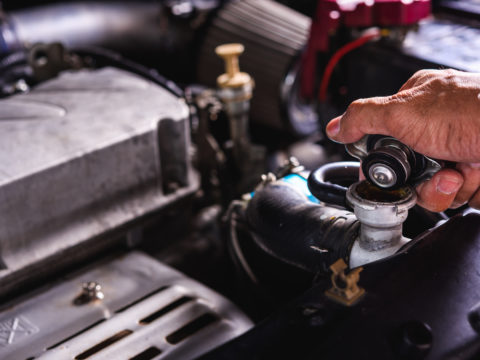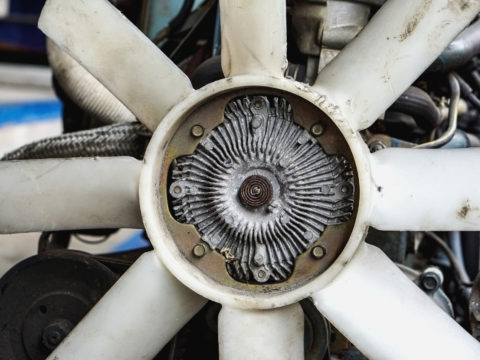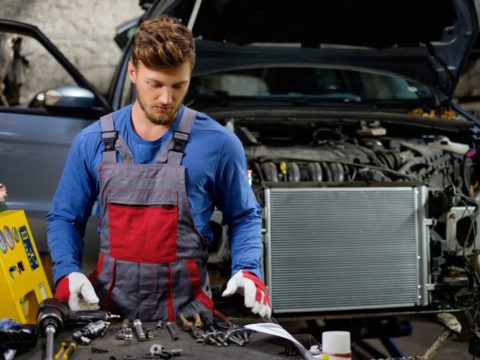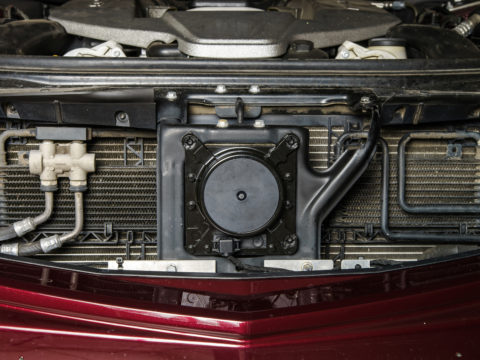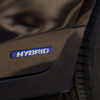Keeping your car’s engine from overheating is vital. When things get hot, your radiator overflow tank plays a critical role in your cooling system, so let’s see how it works and what you need to do if you spot an issue.
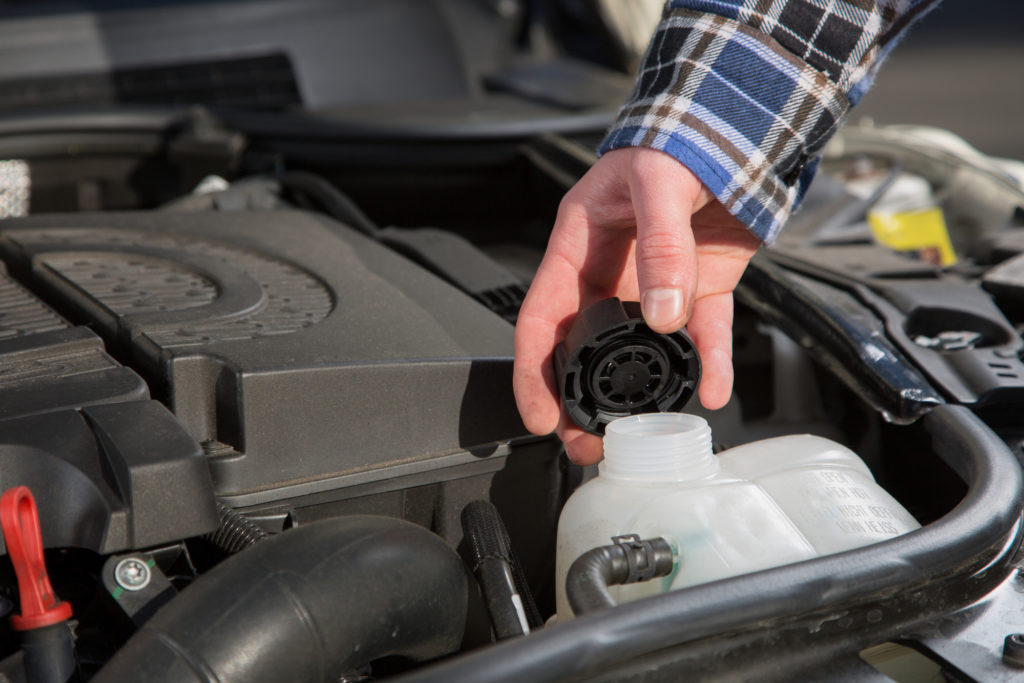
Contents
What Is a Radiator Overflow Tank?
The cooling system on a car uses fluid to transfer the engine’s heat to a radiator, where fresh air interacts with the heated fluid. By the time the fluid cycles through the radiator, a portion of the heat has dissipated.
When the fluid in the cooling system gets hot, it expands, just like when a pot of water on your stove at home gets hot and overflows. A radiator overflow tank allows the pressurized cooling system a little bit of extra room so that when the heated fluid expands, there is enough space for it, and nothing overflows or breaks.
Where Is the Radiator Overflow Tank in a Car?
The radiator overflow tank lives near the top of the radiator. Typically, a tube near the radiator’s cap collects the expanding fluid that doesn’t fit inside the primary cooling system. That captured fluid then flows to the overflow tank.
Radiator Overflow Tank Diagram
Check out this simple diagram to better understand how a typical cooling system works with a radiator overflow tank. If you’d like a more detailed look at a design from a real car, this schematic from a mid-90s BMW 3-Series shows the radiator in the lower-left corner and the radiator overflow tank just to the right of it.
Note how all the hoses connect the radiator and overflow tanks to the engine, the water pump, and other vehicle components. Before working on a radiator system, you have to understand the layout of all the components and how everything fits together.
Is a Radiator Overflow Tank Necessary?
Older cars didn’t have an overflow tank. Instead, the cooling system had a vent or multiple vents that allowed extra pressure to escape the system. That kept the system from exploding when it got hot, but it created pollution. After all, coolant, also known as antifreeze, can be quite toxic. It’s also sweet, so animals might taste it and become sick or even die.
Modern cars require an overflow tank or some sort of expansion system to accommodate the excess pressure without leaking coolant to the atmosphere or dripping it onto the ground, where it could hurt curious animals, people, or the environment.
How Does the Overflow Work on a Radiator?
The radiator overflow tank works by allowing the excess fluid to vent out of the primary cooling system. Since the coolant fluid has expanded as it grew hotter, it no longer all fits inside of the radiator and tubing.
The excess pressure opens a valve, allowing some of the fluid to escape into the overflow tank, preventing a rupture in the cooling system and keeping all the gas and fluid inside of the cooling system.
What Size Radiator Overflow Tank Do You Need?
A standard radiator overflow tank’s design is fairly specific to a given vehicle. The cooling system and the expansion tank are matched so that they will work well together. So, you’ll need a radiator overflow tank that accommodates the size recommended by the vehicle’s manufacturer.
You’ll also need one that fits all the stock mounting points and hose connections. One option you might like in terms of an upgrade isn’t related to size. Changing a stock overflow tank to one made of aluminum offers both an aesthetic and a performance upgrade. That’s because the original tank on your vehicle is usually an ugly yellowish plastic that’s prone to cracking under extreme stress.
Aluminum radiator overflow tanks are shiny, so they look better and are much less likely to crack, even in the most demanding situations.
How Full Should Radiator Overflow Tank Be?
When a car’s engine is cold, the radiator overflow tank should be empty. That’s because as the system cools and the pressure equalizes, the system will naturally and automatically pull the fluid back into the primary cooling system.
Some cars have a bit of extra fluid inside of the radiator overflow even when the car is cold, so always check your owner’s manual. You might even see a mark or two on the plastic overflow reservoir showing a hot and cold fill level. Be careful if you ever top the fluid off while it’s still hot. It’s under pressure, and the fluid can be scalding hot.
The radiator overflow can be anywhere from partially to completely full when the car is hot, depending on how hot things get.
- How to Fill the Overflow Tank?
Some cars require you to fill the system through the overflow tank. So check for a cold fill level marking, and top off the tank with an appropriate coolant and distilled water mix. Some coolants come premixed to make things easier. Just make sure to use a product that is recommended for use in your car.
- How to Drain the Overflow Tank
Each car is a bit different, but typically you can drain an overflow tank in one of two ways. The first way uses a separate vacuum system to evacuate the fluid from the system. The second way is to loosen the lowest hose’s fitting, remove it from the expansion tank and let it flow into a receptacle. You might need to remove the overflow tank to get all the fluid out.
Coolant should always be recycled.
Symptoms of a Faulty Radiator Overflow Tank
- Overheating
If your car is overheating, it likely indicates that there is a problem with the cooling system. That could mean that the radiator overflow tank or one of the other cooling components isn’t working properly.
Don’t drive a car that’s overheated. You should immediately pull over and let the system cool off. Otherwise, you may risk a more severe problem.
- Leaking Coolant
If your vehicle is dripping coolant, you might see a small puddle form on the ground. Overflow tanks are often made of plastic, so they can wear out and crack. Antifreeze can be green, red, blue, or even other colors. But it’s distinctively sweet, and it doesn’t look like oil. See if you can trace where it’s coming from, you may indeed have a cracked overflow tank.
- Coolant Smell
If you are smelling the sweet smell of coolant while driving, something is wrong. If the overflow tank is leaking, cracked, or a fitting is allowing coolant to escape, you will need to fix it.
- Low Coolant Level
If you check your vehicle’s coolant level and it’s down a bit, there might be a leak in the system, and that leak could be in the overflow tank. The leak might be hard to spot from the outside, but it will reveal itself if you top the system off and then let the heat buildup until fluid transfers into the overflow. Keep a close eye and watch for any steam or dribbles that escape it.
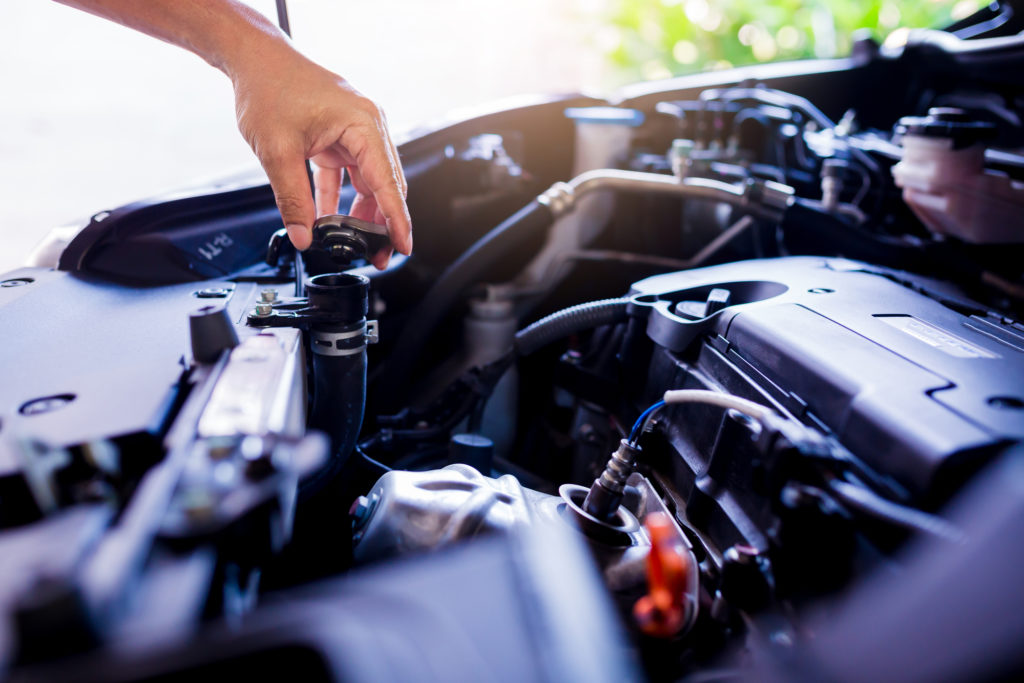
What You Should Do if You Notice a Faulty Overflow Tank
If you notice a faulty overflow tank, you should replace it as soon as possible. Even if that means giving up a day of your weekend to do it yourself or paying a mechanic to do the repair, it’s a lot better than overheating your engine and potentially doing irreparable or costly damage.
Radiator Overflow Tank FAQs
Some radiator overflow questions come up all the time.
Does a radiator overflow tank need a vent?
The overflow itself doesn’t always need a vent, but the cooling system on your car should have a manual or emergency pressure relief valve that will prevent the system from exploding if it gets too hot.
Does a radiator overflow tank need to be higher than the radiator?
Yes, the overflow tank should be positioned above the radiator for the traditional vacuum system to work right. Some cars overcome that requirement with pumps.
Can you fill a radiator through the overflow tank?
You can, and on some cars, that’s part of the system’s design.
Why is radiator overflow tank overflowing?
The overflow tank could be overflowing due to a failure of another component in the cooling system, like the waterpump or the thermostat. When you do a repair on a modern car’s cooling system, it’s often advisable to change the whole system.
What can I use to clean my radiator overflow tank?
You can use a standard cleaning product, like a bucket of soapy water, to clean the outside of your overflow tank. Be careful if you use an engine degreaser, as that could potentially damage the plastic. Don’t clean the inside of the tank. You don’t want anything but coolant fluid in the system.

